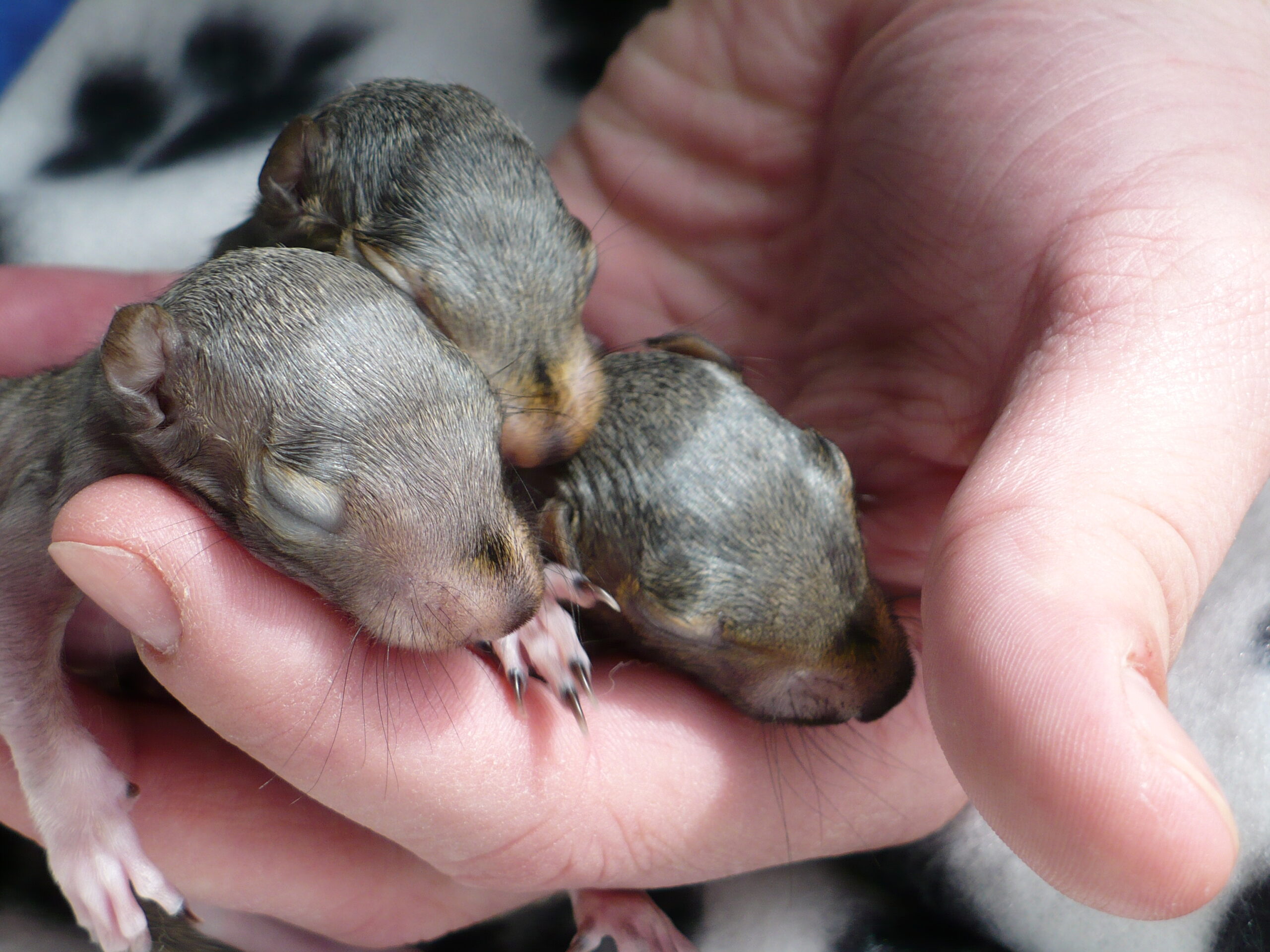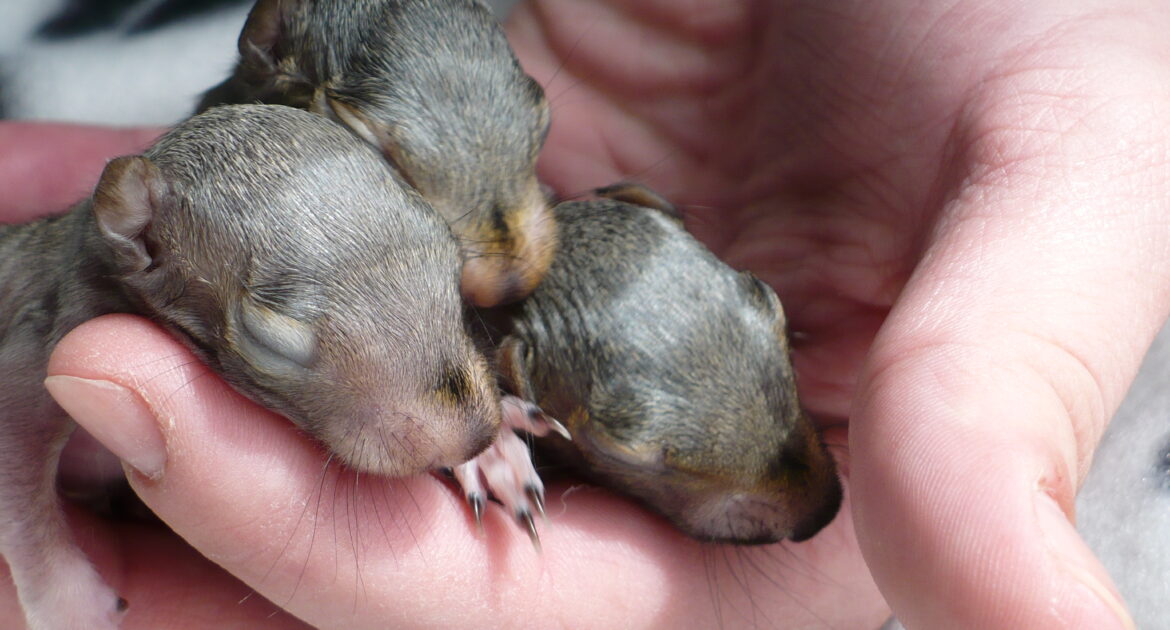From their first squeak-filled days in the safety of a snug nest to their spine-tingling explorations of tree branches, baby squirrels have an incredible growth and learning process.
These tiny animals start life completely dependent on their mother, transforming into agile and clever creatures within just a few months. Wondering what makes baby squirrel growth and development so fascinating?
Let’s explore the magical life stages of these furry youngsters and discover how they learn to survive in their environments.
And don’t worry if squirrels have chosen your home as their nesting site—Skedaddle Humane Wildlife Control in Toronto specializes in safe, professional solutions.
The First Steps in Baby Squirrel Growth
A baby squirrel’s life begins in early spring or late summer, depending on the season. Born blind, deaf, and completely hairless, these newborns weigh less than a loonie. They may seem tiny and fragile, but they’re equipped with an incredible capacity for growth and independence. Within just a few weeks, baby squirrels begin to reach key development milestones.
Their first few days are spent snug gling in their nest, where warmth and their mother’s care keep them alive. A mother squirrel, protective and resourceful, ensures her babies are fed and safe. Nestled high in tree hollows or tucked into attics, they grow stronger daily.
How Baby Squirrels Learn From Day One
Think of a baby squirrel’s early days as their learning foundation. They rely heavily on their mother during this period, not just for food but as their primary teacher.
Though their eyes and ears are closed for the first weeks, they begin to recognize vibrations and scents. It’s as if they learn about the world through touch and smell, setting the stage for more advanced skills down the road.
Development Milestones Baby Squirrels Reach
Baby squirrel growth happens fast. Within just three months, they’re unrecognizable from their squirmy, pink beginnings! Here’s a closer look at the development stages:
- Week 4-5: Eyes Open: By about four weeks old, baby squirrels open their eyes for the first time. This is a monumental moment in squirrel development stages, as vision unlocks a whole new way of experiencing their surroundings. From this point on, they begin observing their environment and their mother’s movements more closely.
- Week 5-6: Fur and Teeth: Shortly after opening their eyes, baby squirrels grow their first coat of fur, and tiny teeth begin sprouting. The fur helps with body temperature regulation while the teeth are critical for nibbling and biting as they transition from their mother’s milk to solid foods.
- Week 7-8: First Explorations: Around eight weeks in, curiosity leads baby squirrels to take their first wobbly steps outside the nest. These exploratory missions are brief, often under the watchful eye of their mother. They learn climbing techniques, food foraging basics, and awareness of potential dangers. It’s like kindergarten for squirrels!
- Week 10-12: Growing Independence: By the time they’re 10 to 12 weeks old, most baby squirrels are much more confident climbers. They’ve mastered some basic survival skills, like recognizing safe foods and navigating tree branches. These milestones prepare them for weaning and eventual independence.
How Baby Squirrels Learn Survival Skills
Learning doesn’t end with milestones. Every day offers lessons in survival for these little ones:
- Observing Their Mother: The mother squirrel plays the most important role in teaching skills. Her actions—whether it’s cracking open nuts, avoiding predators, or building new nests—are like tutorials for her offspring. Baby squirrels watch closely, mimicking her behaviours.
- Practicing by Trial and Error: Baby squirrels aren’t immediately perfect tree navigators or food foragers. They learn through trial and error, much like human toddlers experimenting with new toys. You might spot them hesitating on a wobbly branch or chewing on inedible objects. These experiences build their confidence and teach them valuable problem-solving skills.
- Social Learning: When baby squirrels are part of a bigger litter, they benefit from sibling interactions. Play fights help them hone their reflexes and coordination, while competing for food or space teaches them resourcefulness.
Key Challenges in Squirrel Development Stages
While baby squirrel growth is spectacular, it comes with challenges. Young squirrels face threats from predators, falling from trees, and, unfortunately, taking shelter in urban attics. Their unsteady climbing skills and lack of survival experience make them especially vulnerable during their early months.
If squirrels have nested in your home, it’s easy to misunderstand how fragile and unprepared babies are for a harsh relocation. That’s why Skedaddle Humane Wildlife Control uses one-way doors that allow animals to leave safely but block re-entry. This humane approach protects both the squirrels and your home while respecting wildlife’s natural behaviours.
Fun Facts About Baby Squirrel Growth
Baby squirrels are full of fascinating surprises. Here are a few fun facts you may not know:
- Quick Learners: By just three months old, squirrels can gather and bury food for later use—a skill vital for their survival.
- Constant Growing Teeth: A squirrel’s teeth never stop growing. This is why young squirrels practise gnawing early to maintain healthy teeth lengths.
- Powerful Memory: Even babies have an impressive ability to remember where they stash food. Their survival depends on this.
What Happens When Squirrels Nest in Your Home?
Squirrels are opportunistic and clever, often opting to make their nests in places like attics or chimneys within an urban setting. This can create a lot of issues for homeowners, including:
- Noise: Baby squirrels aren’t shy about chirping or scratching, especially as they grow more active.
- Structural Damage: Chewing on insulation or wood is common as squirrels explore.
- Extended Stay: Once a mother squirrel sees your home as safe, she might return for multiple breeding seasons.
It’s important to address these issues professionally and humanely. At Skedaddle Humane Wildlife Control, we specialize in safely removing squirrels while ensuring they don’t come back, restoring peace to your home.
Skedaddle’s Protective One-Way Door
During squirrel removal, ensuring no babies are left behind is critical. Skedaddle’s professionals inspect attics and other entry points thoroughly, gently guide wildlife out using one-way doors, and seal all potential re-entry spots. This offers a tailored, humane solution that works.
Bright Futures for Baby Squirrels
The incredible baby squirrel growth and development stages prepare these tiny creatures for a life of independence. By learning survival skills from their mother, exploring their surroundings, and overcoming their early vulnerabilities, they become the agile, resourceful squirrels we see darting through Toronto’s parks and trees.
If squirrels have turned your attic into their nursery, remember that DIY methods often fail and could cause harm. Instead, trust our experienced team in Toronto. We offer humane, effective solutions that ensure wildlife thrives while protecting your home.
Time to Take Action
Your home should be your space, and squirrels need an environment that lets them thrive safely. If you suspect an issue, reach out to Skedaddle Humane Wildlife Control in Toronto today! Our experts will assess your situation, remove wildlife responsibly, and prevent future invasions. Request an estimate now, and bring peace back to your home.




